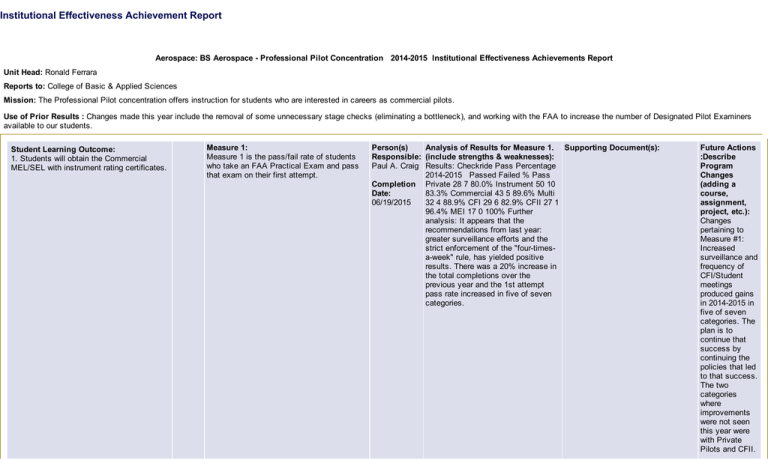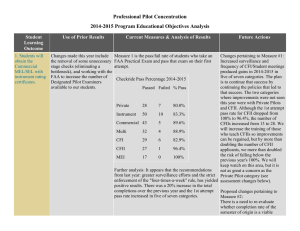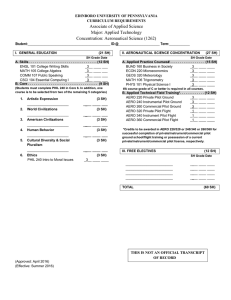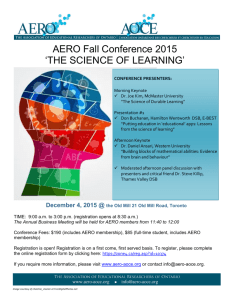Institutional Effectiveness Achievement Report
advertisement

Institutional Effectiveness Achievement Report Aerospace: BS Aerospace ­ Professional Pilot Concentration 2014­2015 Institutional Effectiveness Achievements Report Unit Head: Ronald Ferrara Reports to: College of Basic & Applied Sciences Mission: The Professional Pilot concentration offers instruction for students who are interested in careers as commercial pilots. Use of Prior Results : Changes made this year include the removal of some unnecessary stage checks (eliminating a bottleneck), and working with the FAA to increase the number of Designated Pilot Examiners available to our students. Student Learning Outcome: 1. Students will obtain the Commercial MEL/SEL with instrument rating certificates. Measure 1: Measure 1 is the pass/fail rate of students who take an FAA Practical Exam and pass that exam on their first attempt. Person(s) Analysis of Results for Measure 1. Supporting Document(s): Responsible: (include strengths & weaknesses): Paul A. Craig Results: Checkride Pass Percentage 2014­2015 Passed Failed % Pass Completion Private 28 7 80.0% Instrument 50 10 Date: 83.3% Commercial 43 5 89.6% Multi 06/19/2015 32 4 88.9% CFI 29 6 82.9% CFII 27 1 96.4% MEI 17 0 100% Further analysis: It appears that the recommendations from last year: greater surveillance efforts and the strict enforcement of the "four­times­ a­week" rule, has yielded positive results. There was a 20% increase in the total completions over the previous year and the 1st attempt pass rate increased in five of seven categories. Future Actions :Describe Program Changes (adding a course, assignment, project, etc.): Changes pertaining to Measure #1: Increased surveillance and frequency of CFI/Student meetings produced gains in 2014­2015 in five of seven categories. The plan is to continue that success by continuing the policies that led to that success. The two categories where improvements were not seen this year were with Private Pilots and CFII. Although the 1st attempt pass rate for CFII dropped from 100% to 96.4%, the number of CFIIs increased from 13 to 28. We will increase the training of those who teach CFIIs so improvements can be regained, but by more than doubling the number of CFII applicants, we more than doubled the risk of falling below the previous year's 100%. We will keep watch on this area, but it is not as great a concern as the Private Pilot category (see assessment changes below). Proposed changes pertaining to Measure #2: There is a need to re­evaluate whether completion rate of the semester of origin is a viable measure of success for the Pro­Pilot flight lab courses. Although we have increased the number of required meetings per week from 3 to 4, removed unnecessary stage checks, and worked with the FAA to increase the number of Designated Primary Examiners, our course completion numbers remain very low, as has been the case historically. There are so many variables that the Flight School cannot control (weather, aircraft availability, instructor and student availability, airport/runway closures) that it seems difficult to make headway on this goal. Flight School personnel, the Aerospace Pro Pilot faculty members, and the Aerospace Department Asssessment Committee will review this particular measure during the 2015­2016 academic year, and determine if there is a better measure that can be utilized (i.e., flight hours to completion of certificate). Future Actions :Describe Assessment Changes (measures such as rubrics, exams, diagnostic instruments, etc.): Although the number of Private Pilots increased (from 28 to 35) the 1st attempt pass rate dropped from 89% to 80%. This past year saw an influx of foreign students unlike previous years. With many of the Saudi students, the lack of English proficiency made training and check rides a challenge. Part of our approach for improvement will be to further evaluate the need for improved English language skills/previous language training for our foreign students. One such improvement that will be implemented is a higher initial IELTS and/or TOEFL score requirement for admittance to the Pro­Pilot program, which shall be in effect for any student who entered the program after May 1, 2015. We also recently made changes to our Private Pilot syllabus to further enhance student knowledge and comprehension through additional or revamped ground lessons. As mentioned above, the assessment of completion rate during the semester of origin will be re­ visited as a valid criteria this year. Future Actions :Describe any additional resources needed (Leave blank if no additional resources are needed.): Measure 2: Measure 2 is the percentage rate of students who complete their Flight Lab within the semester of origin. The appropriate FAA Practical Exam must be passed within same semester that the student originally enrolled in the lab. Person(s) Analysis of Results for Measure 2: Responsible: (include strengths & weaknesses): Paul A. Craig Fall 2014 Training Course Completed Students Completion Enrolled Students Completion Rate Date: FITS Private 2 ÷ 12 = 17% FITS 06/19/2015 Instrument 22 ÷ 35 = 63% FITS Commercial 9 ÷ 22 = 41% Part 141 Totals 33 ÷ 69 = 48% Cross Country 5 ÷ 5 = 100% Multiengine 8 ÷ 9 = 89% CFI 13 ÷ 18 = 72% CFII 7 ÷ 9 = 78% MEI 3 ÷ 3 = 100% Part 61 Totals 36 ÷ 44 = 82% Part 141 and 61 Totals Fall 14 69 ÷ 113 = 61% Spring 2015 Training Course Completed Students Enrolled Students Completion Rate FITS Private 5 ÷ 35 = 14% FITS Instrument 11 ÷ 18 = 61% FITS Commercial 13 ÷ 23 = 57% Part 141 Totals 29 ÷ 76 = 38% Cross Country 2 ÷ 2 = 100% Multiengine 16 ÷ 16 = 100% CFI 2 ÷ 4 = 50% CFII 13 ÷ 13 = 100% MEI 6 ÷ 6 = 100% Part 61 Totals 39 ÷ 41 = 95% Part 141 and 61 Totals Spring 15 68 ÷ 117 = 58% Totals for 2014­2015 Year 137 230 60% * all numbers are from beginning of semester to date grades are due for term Comparison of Last Academic Year (2013­2014) Semester of Origin Start of semester to EOC by time Grades Due Start of semester to Checkride by start of next semester Fall 2013 23% 68% Spring 2014 60% 62% Analysis: For comparision purposes, only the completion rate by the date grades were due was considered. The fall 2014 rate was 61%, versus 23% during the fall of 2013. The spring 2015 rate was 58%, which is slightly lower than the 60% in the spring of 2014. While many efforts in various areas have been made to increase the completion rate within a semester, this efforts are largely unable to address the difficulties provided by external factors such as weather and maintenance. See discussion under "Future Actions" regarding the potential revision of this outcome measure during the next academic year. Use of Prior Results : Changes this year include the addition of a cadre of FTD instructors that now includes five active airline pilots either currently or recently flying the CRJ 200 in airline operations. Classroom instructors now includes an MTSU assistant professor with extensive airline training and flying experience and corporate jet flying experience who also serves as one of the FTD instructors. Additionally, there are now two courses in which students experinece acting as a first officer under Part 121 in a crewed, turbine­powered aircraft. AERO 3240 is now the introduction to crewed, turboprop aircraft (BE­1900), providing a much more firm foundation for our students to transition into the CRJ ATD utilized in AERO 4250. Student Learning Outcome: 2. Students should exhibit the ability to act as a first officer under CFR Part 121 in a crewed, turbine­powered aircraft. Measure 1: Measure 1 is the completion rate of students in AERO 3240 and 4250. Explanation: Aero 3240 is the prerequisite course for Aero 4250. Aero 3240 is an introduction to advanced turboprop aircraft utilizing a Frasca Beech 1900 FTD. FTD flight training consists of six hours of crew operational flying, including a Line Oriented Flight Training session. The sequence of Aero 3240 to Aero 4250 is intended to be a two­step program from light twin­engine, single pilot operations introducing the students sequentially to more advanced systems and operating environments with crew coordination and airline operations procedures. Aero 4250 is the capstone flight training course utilizing a Frasca CRJ 200 FTD. The course provides training in advanced, high altitude, turbine powered (turbo fan) aircraft operations emphasizing crew coordination procedures in a Part 121 air carrier environment. Classroom training is completed in stage 1 and stage 2 is the FTD training. The course final is a Line Oriented Flight Training exercise including the requirements for a high altitude endorsement. This is a Part 141 course. Person(s) Analysis of Results for Measure 1. Supporting Document(s): Responsible: (include strengths & weaknesses): Paul Craig Results for AERO 3240: Fall 2014 class: 16 students, 16 passed. Completion (Seven of these students progressed Date: to the spring Aero 4250 course.) 05/10/2015 Spring 2015 class: 20 students, 20 passed. June 2015 class: 9 students, 9 passed. Results for AERO 4250: Fall 2014 class: 11 students enrolled, 10 passed, 1 incomplete (re­enrolled and passed the spring 2015 class) Spring 2015 class: 12 students, 12 passed. (7 of these students completed the fall 2014 Aero 3240 course) Future Actions :Describe Program Changes (adding a course, assignment, project, etc.): An instructor meeting in August provides for review of student progress, course design changes, new emphasis areas, standardization, and recommendations for revisions based on the previous year experiences. Future Actions :Describe Assessment Changes (measures such as rubrics, exams, diagnostic instruments, etc.): Future Actions :Describe any additional resources needed (Leave blank if no additional resources are needed.): Report Date: Mon Aug 10 2015 13:35:58 CDT Close



